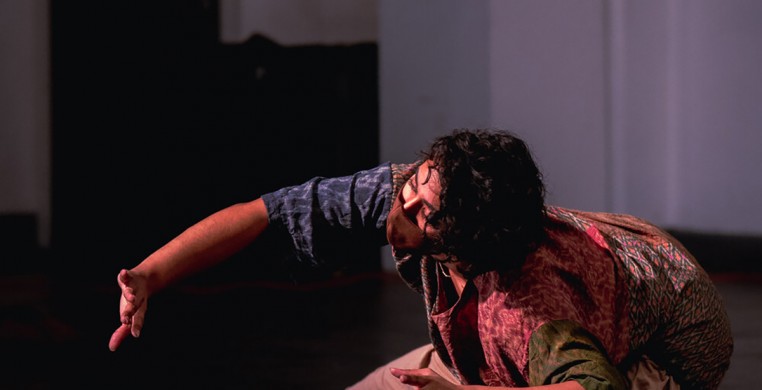Bam! Garlic and onions. Whango! Coconut oil and cumin. Biff! Sharp, fresh ginger.
From the second you step into the 1700 Theater at Steppenwolf, you are hit with the pungent and pleasing aromas of ingredients cooking in two pans over hot plates, doted over by artist and creator of “Bangali Meye,” Tuli Bera, and guest performer Anita (Tithi) Bera. Early arrivals are invited to inspect the cooking area—two tables atop which sit herbs, spices, oils and vegetables indicative of Indian cuisine.
Tuli, self-described as “a human with short, black hair…with a settler-ish American identity,” begins by giving thanks to those who’ve inspired the work, most notably her sister and co-performer, Anita. Growing more serious, Tuli’s large, expressive eyes begin to swell and water as she speaks, and then—
Suddenly, the lights over the “kitchen” dim. A ghostly apparition (Anita) appears in the background, unnoticed until now. Face covered, Anita sings a melody (a combo of two songs by Norah Jones) while moving in between large, colorful hanging tapestries of silk and chiffon. The only accompaniment is the sizzling of the frying pan—a haunting juxtaposition! The steam rising from the pan augments the eerie atmosphere as Anita rolls upstage, wrapping herself in a long river of fabric.
Later, Tuli takes center stage in a trance-like dream state, her movements a combination of ballet, Bharatanatyam and modern dance styles. Turned out feet display proper ballet technique. Modern dance abstractions allow the imagination to add meaning—arms drawn backwards, fists pounding loudly up the length of the spinal column. More specific movements draw a more distinct narrative—a Bharatanatyam-inspired hand mudra plucks invisible fruit, stored in a pocket and cautiously eaten. Moving far right to a woven mat, the bodily control displayed by Tuli is like a turbulent wave, each movement flowing into the next.
“Bangali Meye’s” four dance works are broken up by returns to the “kitchen,” where Tuli and Anita reminisce about past moments and measure ingredients according to the pages of a recipe book. It’s difficult to tell which parts of the conversation are prepared or off the cuff. As soon as you relax into the story of a funny memory, the lights again grow dim, Tuli’s body stiffens, head and eyes rolling back, as if possessed and carried away as the voice of her sister fades. Every transition expertly done catches me off guard.
For a work in progress, “Bangali Meye,”—which translates to Bangali girl—is thoughtfully cohesive. Some of the prepared monologue is repetitive. The rhetorical tactic of stressing different words on repeating phrases is interesting up to a point. But this is nitpicking. If anything, the seeming unpreparedness of the “kitchen” segments are effective in disarming the viewer, making the vibrant and minimalist dance and singing sections pop out.
And, holy smokes, the smells! Each aroma accents the work in a profound way. Imagine the smell of fresh garlic and spices thrown into a hot pan of oil; now, imagine that amazing smell persisting and renewing over and over again. Olfactory heaven!
In “Bangali Meye,” family, food and fantastic dancing and singing combine via artful transitions to create a work that is otherworldly, yet relatable and intimate. Tuli’s utilization of different movement styles—a pinch of ballet, a dash of Rajasthani folk dance—both bring to life her family’s anecdotes and serves as a metaphor for her multi-cultural background. She combines these ingredients like a culinary expert wields flavor. That it is a work in progress is even more impressive. If “Bangali Meye” ever turns into a full course, please, mark my reservation in advance.

